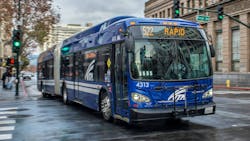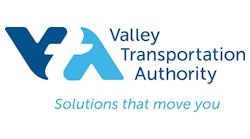VTA Demonstrates Innovative Smart Stop Technology
Waiting for a bus is about to enter the “smart technology” era, as the Santa Clara Valley Transportation Authority teams up with two high-tech leaders in the automotive ecosystem –Renesas Electronics America Inc. and eTrans Systems – to demonstrate a new application to improve the rider experience through technology innovation.
A cutting-edge application, referred to as a “Smart Stop” that works between buses and waiting passengers was demonstrated at the annual conference of the Intelligent Transportation Society of America (ITS America), going on this week in San Jose.
A bus stop can become very crowded and confusing when serving multiple bus routes, or during bad weather the passenger may be in a location difficult to be seen by the driver. Developed with leading global automotive semiconductor supplier Renesas Electronics America and eTrans Systems, a leading developer of software solutions for connected and automated vehicles, the Smart Stop demonstration is designed to highlight V2I (Vehicle-To-Infrastructure) and V2V (Vehicle-To-Vehicle) solutions using Dedicated Short Range Communications, or DSRC, for safety and mobility applications.
V2X technology connects the fleet systems with infrastructure, using 5.9 GHz WI-FI communications, allowing vehicles to reliably interact with infrastructure, enabling collision avoidance, and promoting fuel efficiency making ridership a greener efficient experience.
“VTA is looking for new and inventive ways to improve the customer experience when taking transit,” said Gary Miskell, VTA’s chief information officer. “A Smart Stop provides customers a quick and simple way to keep them informed on their trip.”
“It’s an exciting time for the transportation industry, and Renesas Electronics America is pleased to partner with VTA and eTrans Systems to demonstrate the first eco-friendly solution for V2X,” said Vinay Thadani, senior staff product marketing manager, automotive unit, Renesas Electronics America, and ITS California committee member. “Connecting the innovation of transit, vehicle, and infrastructure of the VTA, while using a Renesas On-Board Unit with eTrans Systems technologies, Smart Stop will promote safety and greener ridership in overall transit.”
eTrans Systems has designed communications software that allows the bus and the bus stop to communicate using DSRC technology.
"DSRC is an emerging technology that is going to greatly improve road safety and mobility and we are very excited to rollout this cutting-edge solution with VTA," said John Estrada eTrans Systems CEO.
A mock Valley Transportation Authority bus stop was used to demonstrate the use of DSRC to let a bus operator know if someone is waiting at a particular stop, and to let passengers know when the bus is nearby. This will allow buses to avoid having to stop when there are no passengers waiting, which saves time and fuel.
When passengers arrive at a bus stop, they can use an app on their smartphone or the touch screen at the bus stop kiosk to indicate that they are waiting for a particular bus. This request is then passed to a Road Side Unit that runs software developed by eTrans Systems. The Road Side Unit then uses DSRC technology to transmit that request to the bus on-board unit which generates an audible and visual alert. As the bus approaches the bus stop, DSRC communication is used to notify the passenger, via their smartphone, that the bus is approaching.
A second demonstration of DSRC technology featured Renesas Electronics advanced ADAS autonomous driving platform, which uses a combination of sensor fusion, 3D surround view, and V2X technologies to provide driver warnings for collisions, red lights and road construction. NHTSA has stated that V2X technology can reduce up to 80% of the crashes in the U.S. Regulations expected to go into effect will eventually mandate V2X technology to be integrated with existing vehicle safety features to optimize driver safety and fuel efficiency. Many major auto manufacturers have already begun to respond to the new mandate, which is proposed for vehicles manufactured for model year 2019.


